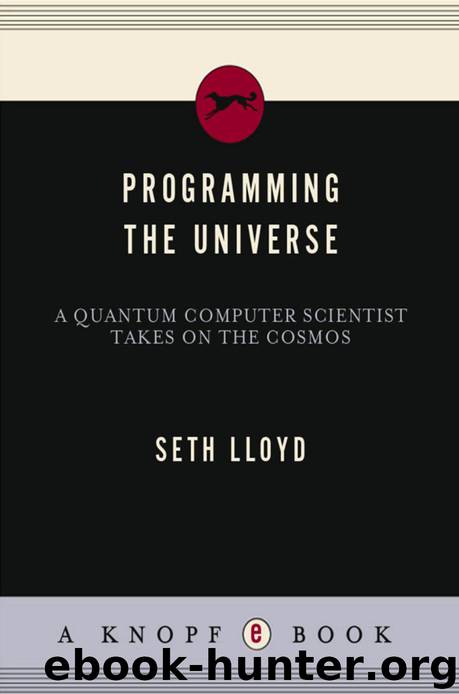Programming the Universe: A Quantum Computer Scientist Takes on the Cosmos by Lloyd Seth

Author:Lloyd, Seth [Lloyd, Seth]
Language: eng
Format: epub, mobi
Tags: Itzy, Kickass.to
ISBN: 9780307264718
Amazon: B000GCFBP6
Publisher: Knopf
Published: 2006-03-01T05:00:00+00:00
Entanglement
Another difference between the classical and quantum versions of the controlled-NOT is that in the quantum case, information is created, apparently from nothing. Recall the analogous classical process: the particle bit could have been in either the state 0 or the state 1 to begin with; it had one bit of entropy. Here, the qubit is in a well-defined state: its entropy is zero. Of course, the state that the qubit is in, |0Ò + |1Ò, is one that has elements of both |0Ò and |1Ò: like the corresponding state of the particle in the double-slit experiment, this state is a curious quantum state in which the quantum bit in some sense registers 0 and 1 at the same time.
When the two classical bits interacted via the controlled-NOT, the entropy in the particle bit infected the detector bit. The two bits were now correlated and the entropy of the detector bit had increased. When the two qubits interact via the quantum controlled-NOT, they also become correlated, and the entropy of the detector qubit increases. But this entropy did not come from the particle qubit. In the quantum case, before the controlled-NOT was applied, the particle qubit was in a well-defined state with zero entropy. Where did the information come from?
What’s going on is that quantum mechanics, unlike classical mechanics, can create information out of nothing. Take our two qubits in their correlated state, |00Ò + |11Ò, with the wave of the first qubit correlated with the wave of the second qubit. This state is a definite quantum state: its entropy is zero. But now each of the qubits on its own is in a completely indefinite state: each could be either |0Ò or |1Ò. That is, each quantum bit now has one full bit of entropy.
This weird type of quantum correlation is called “entanglement.” If a classical system is in a definite state, with zero entropy, then all the pieces of the system are also in a definite state, with zero entropy. If we know the state of the whole, then we also know the state of the pieces. For example, if two bits are in the state 01, then the first bit is in the state 0 and the second bit is in the state 1. But when a quantum system is in a definite state, though, such as the correlated state of our quantum bits, the pieces of the system need not be in a definite state. In entangled states, we can know the state of a quantum system as a whole but not know the state of the individual pieces.
When the pieces of a quantum system become entangled, their entropies increase. Almost any interaction will entangle the pieces of a quantum system. The universe is a quantum system, and almost all of its pieces are entangled. Later, we’ll see how entanglement allows quantum computers to do things that classical computers can’t do. Here, we see that entanglement is responsible for the generation of information in the universe.
Download
Programming the Universe: A Quantum Computer Scientist Takes on the Cosmos by Lloyd Seth.mobi
This site does not store any files on its server. We only index and link to content provided by other sites. Please contact the content providers to delete copyright contents if any and email us, we'll remove relevant links or contents immediately.
The Complete Stick Figure Physics Tutorials by Allen Sarah(7307)
Secrets of Antigravity Propulsion: Tesla, UFOs, and Classified Aerospace Technology by Ph.D. Paul A. Laviolette(5309)
Thing Explainer by Randall Munroe(3877)
The River of Consciousness by Oliver Sacks(3536)
The Order of Time by Carlo Rovelli(3145)
How To by Randall Munroe(3033)
A Brief History of Time by Stephen Hawking(2960)
I Live in the Future & Here's How It Works by Nick Bilton(2935)
The Great Unknown by Marcus du Sautoy(2646)
What If?: Serious Scientific Answers to Absurd Hypothetical Questions by Randall Munroe(2637)
Midnight in Chernobyl by Adam Higginbotham(2483)
Blockchain: Ultimate Step By Step Guide To Understanding Blockchain Technology, Bitcoin Creation, and the future of Money (Novice to Expert) by Keizer Söze(2445)
Networks: An Introduction by Newman Mark(2360)
The Meaning of it All by Richard Feynman(2299)
Easy Electronics by Charles Platt(2281)
The Tao of Physics by Fritjof Capra(2229)
Midnight in Chernobyl: The Untold Story of the World's Greatest Nuclear Disaster by Adam Higginbotham(2177)
When by Daniel H Pink(2082)
Introducing Relativity by Bruce Bassett(2076)
